Electrode Layout Optimization and Numerical Simulation of Cast Conductive Asphalt Concrete Steel Bridge Deck Pavement
Abstract
:1. Introduction
2. Materials and Methods
2.1. Asphalt
2.2. Aggregates and Mineral Powder
2.3. Conductive Materials
2.4. Electrode Material
2.5. Preparation of Pouring Conductive Asphalt Concrete
2.6. Electrode Layout Form
2.6.1. Left and Right External Electrode Layout
2.6.2. Layout of Left and Right Embedded Electrodes
2.7. Finite Element Analysis
2.7.1. Parameter Determination of Finite Element Analysis
2.7.2. Finite Element Simulation of Ice-Snow Melting of Pouring Conductive Asphalt Concrete Slab
2.7.3. Application and Solution of Boundary Conditions for Ice Melting Model
2.8. Mechanical Analysis
Basic Parameters and Models for Finite Element Analysis of Steel Bridge Deck Pavement
3. Results and Discussion
3.1. Influence of Electrode Thickness on Temperature Rise of Specimen
3.2. The Ice-Snow Melting Effect with Insulation Layer
3.3. Effect of Snow Melting without Insulation Layer
3.4. Relationship between Ice Thickness, Melting Time and Voltage
3.5. Comparison of Ice Melting Effect with and without Insulation Layer
3.6. Surface Stress and Strain Analysis of Steel Bridge Deck Pavement
3.6.1. Longitudinal and Transverse Stress Analysis of Pavement Surface under Different Load Positions
- Under the condition of constant elastic modulus, the transverse maximum tensile stress and compressive stress on the surface of steel bridge deck pavement without a temperature field were much larger than the longitudinal maximum tensile stress and compressive stress. Because the pavement was a three-dimensional space body, the maximum principal stress was not easy to determine, so the transverse tensile stress can be used as an index of pavement design.
- The maximum tensile stress of the pavement surface under different loading positions were for loading position 1, loading position 2, and loading position 3, 0.3588 MPa, 0.3599 MPa, and 0.4130 MPa, respectively. When the temperature field was applied, the difference of longitudinal and transverse stress values on the surface of the pavement layer decreased, but the transverse tensile and compressive stress values were still greater than the longitudinal tensile and compressive stress values. The maximum tensile stress on the surface of the pavement layer was 0.4511 MPa, 0.4554 MPa and 0.4783 MPa at loading position 1, 2 and 3, respectively, which increased by 25.7%, 26.5% and 15.8%, respectively. Therefore, it can be seen that the temperature field increases the surface tensile stress of the pavement layer. The transverse tensile stress under the action of load position 3 was still the largest, and load position 3 can be used as the most unfavorable transverse load position.
- The location of the maximum tensile stress in the transverse direction of the pavement surface was 2.4 m, 2.4 m and 2.64 m in the transverse direction of the bridge deck according to the position sequence of the load position. The temperature field had no effect on the location of the maximum tensile stress, but the effect of the temperature field made the maximum compressive stress of the pavement surface smaller.
3.6.2. Longitudinal and Transverse Strain Analysis of Pavement Surface under Different Loading Positions
3.7. Analysis of Longitudinal and Transverse Shear Stress between Pavement Bottom and Steel Plate
3.7.1. Analysis of Longitudinal and Transverse Shear Stress between Pavement and Steel Plate under Different Loading Positions
3.7.2. Longitudinal and Transverse Shear Strain Analysis between Pavement and Steel Plate under Different Loading Positions
4. Conclusions
- The stainless steel sheet electrode material used in pouring conductive asphalt concrete has an excellent heating rate, convenient construction, low cost, high safety, and can maintain its stable conductivity during snow melting and ice melting.
- The electrode layout scheme of pouring asphalt concrete based on melting snow was analyzed. The effects of different electrode layout schemes and electrode thickness on heating rate and snow removal were compared and evaluated. Finally, it was concluded that the buried stainless steel metal mesh was the optimal electrode layout.
- In the process of finite element simulation of the influence of different voltage inputs on the ice melting thickness, the larger the voltage input, the shorter the ice melting time. With the increase in voltage, the difference in large ice melting time becomes smaller, and the pavement structure with a thermal insulation layer can improve the ice melting efficiency more effectively. The snow melting and deicing time difference between the simulation and the indoor test was short, and the finite element simulation results are credible.
- The most unfavorable load position of pouring conductive asphalt concrete steel bridge deck pavement under single wheel load and temperature field is mid-span load position 3, and the maximum tensile stress and maximum compressive stress on the pavement surface are transverse. Through comparative analysis, it was found that the maximum transverse stress of the pavement surface increases slightly when the temperature field exists, and the unfavorable loading position remains unchanged. The temperature field has little effect on the low shear stress and shear strain of the pavement.
Author Contributions
Funding
Institutional Review Board Statement
Informed Consent Statement
Data Availability Statement
Conflicts of Interest
References
- Xia, H.Y.; Zhao, X.; Wu, Y.C.; Yuan, T.; Song, L.F.; Yan, M.J.; Wang, F.Y.; Chen, H.X. Preparation and performance of antifreeze adhesive materials for asphalt pavement. Constr. Build. Mater. 2020, 258, 119554. [Google Scholar] [CrossRef]
- Tan, Y.Q.; Xu, H.N.; Zhang, C. The old methods and new technologies of snow removal. Chin. Highw. 2018, 3, 59–63. [Google Scholar]
- Zheng, S.P.; Cheng, C.H.; Fang, R.; Li, Y.J.; Zhou, P.Y. Discussion on Application of Conductive Asphalt Concrete in Snow Melting and Ice Melting of Road Engineering. Highw. Traffic Technol. Appl. Technol. Ed. 2015, 11, 77–79. [Google Scholar]
- Liu, Z.S.; Wu, S.B.; Liu, P.F.; Hu, G.P. Research Progress of Conductive Asphalt Concrete and Its Functional Properties. Mater. Rep. 2017, 31, 374–378. [Google Scholar]
- Huang, W.R.; Yang, Y.Z.; Song, P.; Guo, J.C.; Zhong, X.X.; He, X. Study on electrothermal performance of graphene-carbon fiber conductive asphalt concrete. N. Chem. Mater. 2021, 49, 269–273. [Google Scholar]
- Guo, R.H.; Zhang, H.H.; Tan, Y.X. Influence of salt dissolution on durable performance of asphalt and Self-ice-melting asphalt mixture. Constr. Build. Mater. 2022, 346, 128329. [Google Scholar] [CrossRef]
- Peng, C.; Hu, Y.D.; You, Z.P.; Yang, H.; Nie, Y.T.; Wu, T.H.; Yang, H.N.; Ou, R.H. Preparation and anti-icing performance of acrylic superhydrophobic asphalt pavement coating with microwave heating function. Constr. Build. Mater. 2022, 344, 128289. [Google Scholar] [CrossRef]
- Guo, Q.L.; Liu, Q.; Wu, C.L.; Li, L.L.; Li, C.M.; Liu, F.C. Local temperature field and healing effect of conductive asphalt and mixture cracks. J. Jilin Univ. Eng. Ed. 2022, 52, 1386–1393. [Google Scholar]
- Cheng, Z.H.; Chen, X.F.; Zheng, S.P.; Hou, R.G.; Chen, H.B. Study on conductive asphalt concrete material and construction technology. Highw. Traffic Technol. Appl. Technol. Ed. 2017, 13, 89–91. [Google Scholar]
- Tan, Y.Q.; Liu, K.; Wang, Y.Y. Nonlinear Voltammetric Properties of Carbon Fiber/Graphene Conductive Asphalt Concrete. J. Build. Mater. 2019, 22, 278–283. [Google Scholar]
- Liu, K.; Xu, P.; Wang, F.; Jin, C.; Liu, Q.T.; Pang, H.P.; Xie, H.Z. The accumulated stress damage and residual life prediction of unreinforced concrete pavement with electric heating pipes. Constr. Build. Mater. 2021, 278, 122258. [Google Scholar] [CrossRef]
- Su, X.; Lai, Y.; Liu, Y.; Ma, D.X.; Wang, P. Research of Deicing and Melting Snow on Airport Asphalt Pavement by Carbon Fiber Heating Wire. Adv. Mater. Sci. Eng. 2020, 2020, 5209350. [Google Scholar] [CrossRef]
- Phan, T.M.; Park, D.-W.; Kim, H.-S. Utilization of micro encapsulated phase change material in asphalt concrete for improving low-temperature properties and delaying black ice. Constr. Build. Mater. 2022, 330, 127262. [Google Scholar] [CrossRef]
- Zha, X.D.; Hu, H.W.; Zhang, C.J.; Luo, T. Development and Laboratory Simulation Tests of Anti-skidding Ice Melting Cushion with Carbon Fibers for Pavement. Int. J. Pavement Res. Technol. 2021, 15, 1251–1261. [Google Scholar] [CrossRef]
- Wang, C.H.; Han, X.X.; Chen, J.; Hou, R.G.; Zheng, S.P. Heat conduction effect of cast conductive asphalt concrete. Mater. Rep. 2018, 32, 3891–3899. [Google Scholar]
- Chen, Q.; Wang, C.H.; Fan, Z.T.; Hou, R.G.; Chen, J. Heat conduction effect prediction model of cast conductive asphalt concrete composite structure. Mater. Rep. 2019, 33, 1659–1665. [Google Scholar]
- Wang, C.H.; Chen, Q.; Gao, Z.W.; Jiang, T.T.; Chen, J. Status and Development of Cast Asphalt Concrete. Mater. Rep. 2017, 31, 135–145. [Google Scholar] [CrossRef]
- Li, K.; Xie, H.Z.; Jin, C.; Huang, S.L.; Wang, F. The equivalent plasticity strain analysis of snow-melting heated pavement concrete exposed to inner elevated temperatures. Constr. Build. Mater. 2017, 137, 118–125. [Google Scholar] [CrossRef]
- Liu, K.; Xie, H.Z.; Xu, P.X.; Wang, Z.; Bai, H.J.; Wang, F. The thermal and damage characteristics of an insulated-conductive composite structure for the heated bridge deck for snow-melting. Constr. Build. Mater. 2019, 216, 683–696. [Google Scholar] [CrossRef]
- Wang, H.P.; Yang, J.; Liao, H.; Chen, X.H. Electrical and mechanical properties of asphalt concrete containing conductive fibers and fillers. Constr. Build. Mater. 2016, 122, 184–190. [Google Scholar] [CrossRef] [Green Version]
- Wang, Z.H.; Bai, E.L.; Huang, H.; Wang, T.J.; Sun, H.Y. Study on the electromagnetic property and microwave heating efficiency of concrete with magnetite aggregate. Constr. Build. Mater. 2022, 342, 128080. [Google Scholar] [CrossRef]
- Xu, P.X.; Zhang, D.R.; Miao, Y.; Muhammad, S.B.; Zhang, K. Development and characterization of a novel steel slag-based composite phase change aggregate for snow/ice melting of asphalt pavements. Constr. Build. Mater. 2022, 341, 127769. [Google Scholar] [CrossRef]
- Pan, P.; Wu, S.P.; Hu, X.D.; Wang, P.; Liu, Q.T. Effect of freezing-thawing and ageing on thermal characteristics and mechanical properties of conductive asphalt concrete. Constr. Build. Mater. 2017, 140, 239–247. [Google Scholar] [CrossRef]
- Wei, H.B.; Ma, Z.P.; He, X.; Han, S.Y.; Jiang, B.Y. Structural response analysis of conductive ethylene–propylene–diene monomer rubber composite pavement under validated temperature field. Constr. Build. Mater. 2022, 328, 127094. [Google Scholar] [CrossRef]
- Malakooti, A.; Theh, W.S.; Sadati, S.M.; Sajed, C.H.; Kim, S.; Mina, M.; Cetin, K.; Taylor, P.C. Design and Full-scale Implementation of the Largest Operational Electrically Conductive Concrete Heated Pavement System. Constr. Build. Mater. 2020, 255, 119229. [Google Scholar] [CrossRef]
- Gao, Y.L.; Qu, L.C.; He, B.; Dai, K.M.; Fang, Z.S.; Zhu, R.J. Study on effectiveness of anti-icing and deicing performance of super-hydrophobic asphalt concrete. Constr. Build. Mater. 2018, 191, 270–280. [Google Scholar] [CrossRef]
- Sun, W.Z.; Li, X.; Yang, Q.; Zhang, H.G. Resistivity-temperature characteristics of conductive asphalt concrete. J. Wuhan Univ. Technol. Mater. 2016, 31, 1–6. [Google Scholar] [CrossRef]
- Li, Z.X.; Guo, T.T.; Chen, Y.Z.; Lu, Y.; Niu, X.J.; Yang, X.; Jin, L.H. Study on Road Performance and Electrothermal Performance of Poured Conductive Asphalt Concrete. Adv. Mater. Sci. Eng. 2022, 2022, 2462126. [Google Scholar] [CrossRef]
- Zhu, Y.; Zhang, Q.F.; Chen, L.; Du, Z. Mechanical response of hydronic asphalt pavement under temperature–vehicle coupled load: A finite element simulation and accelerated pavement testing study. Constr. Build. Mater. 2021, 272, 121884. [Google Scholar] [CrossRef]
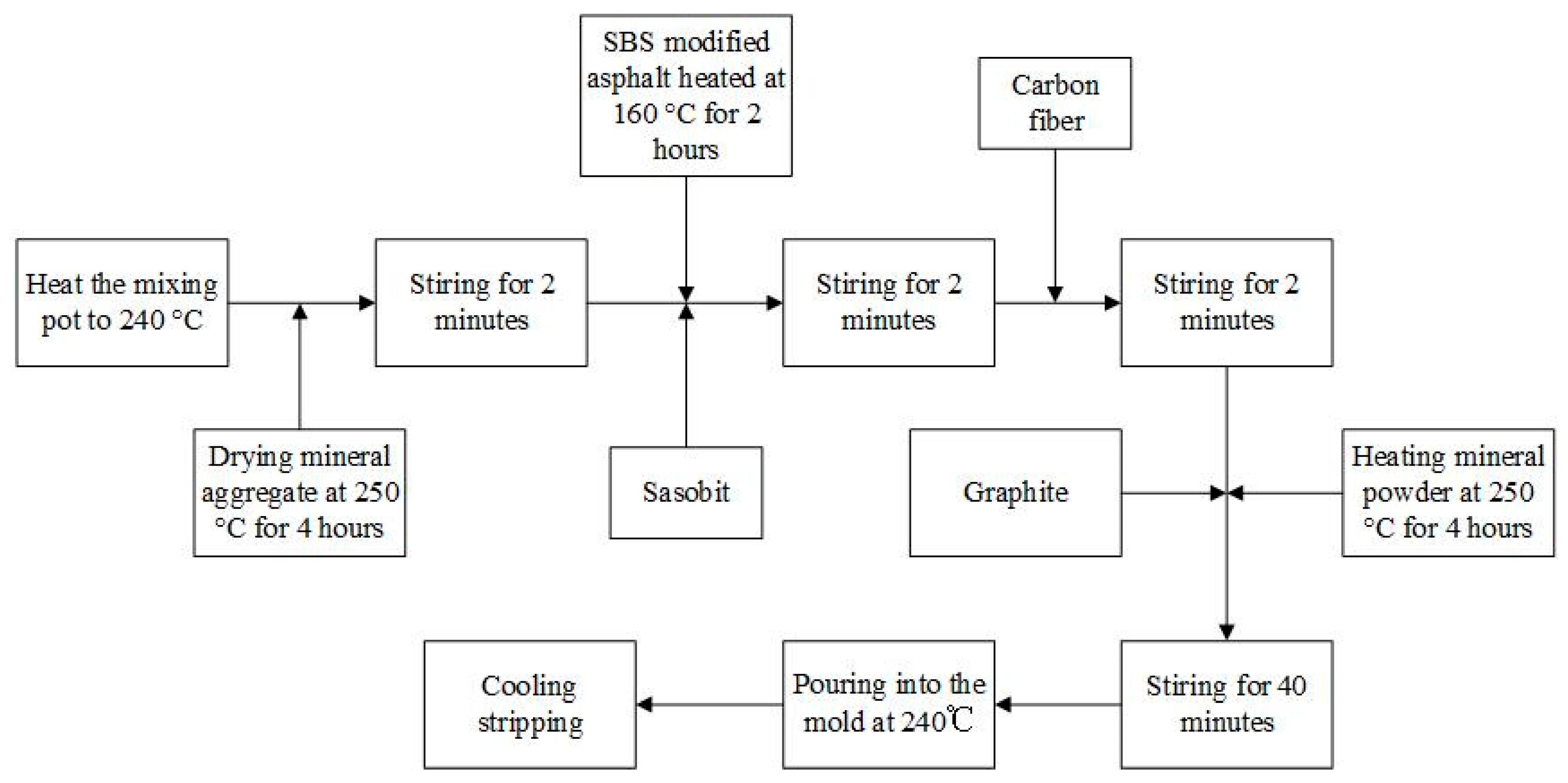
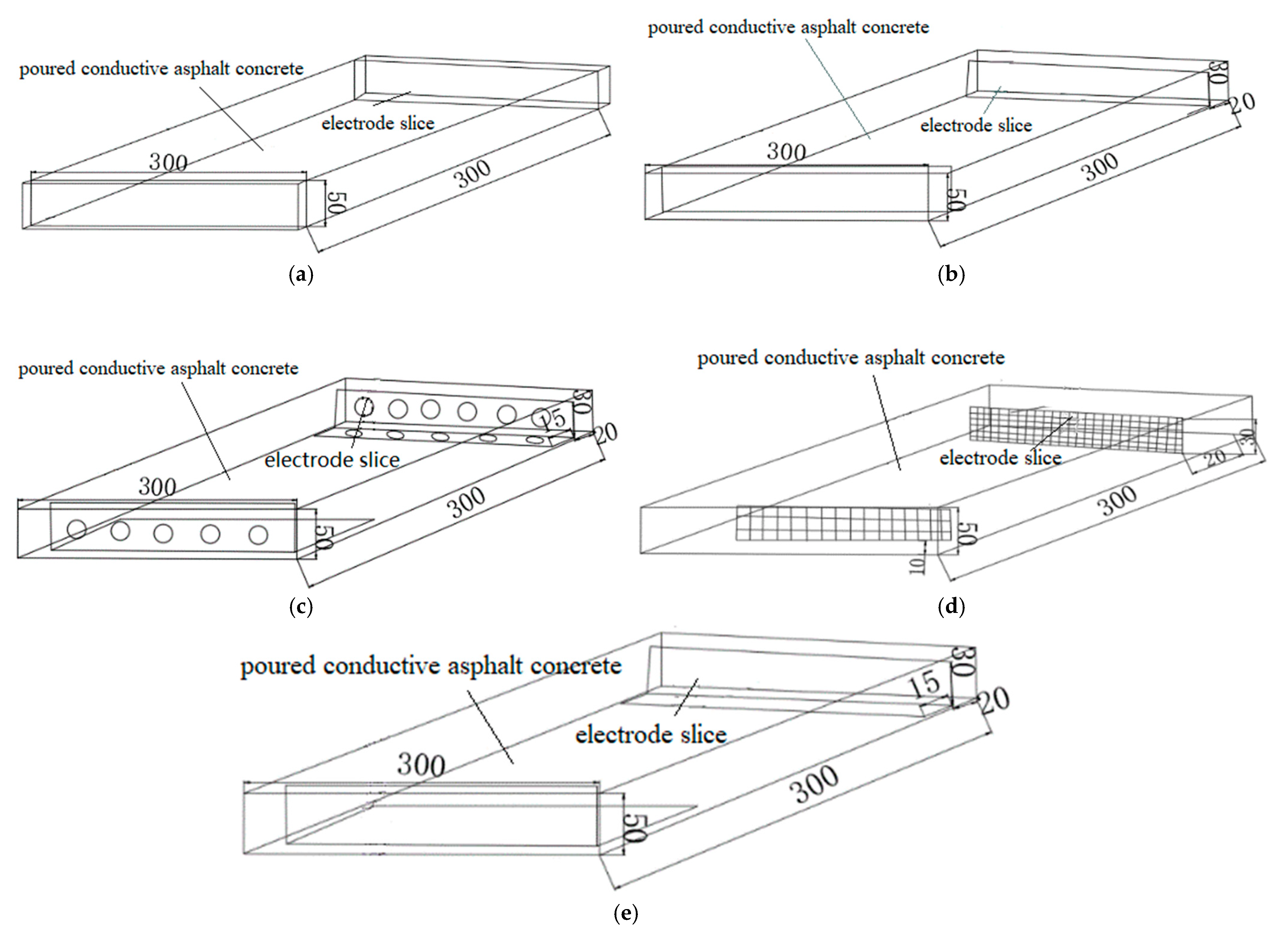
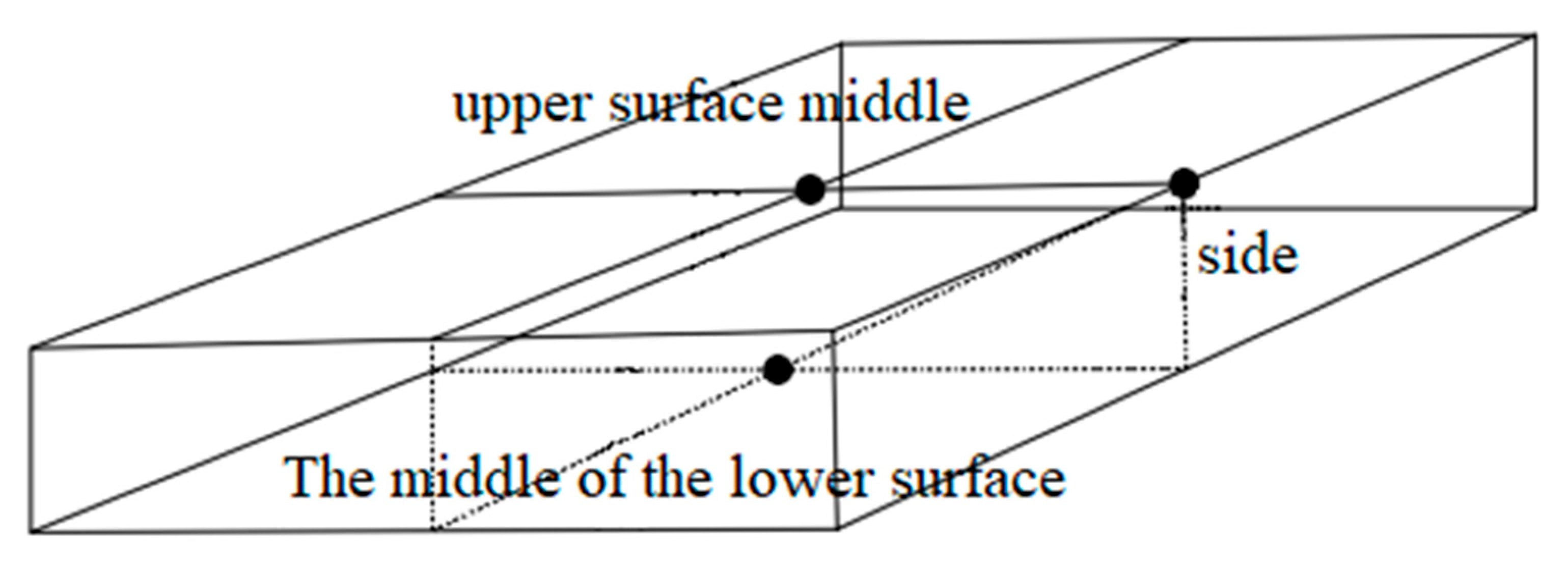
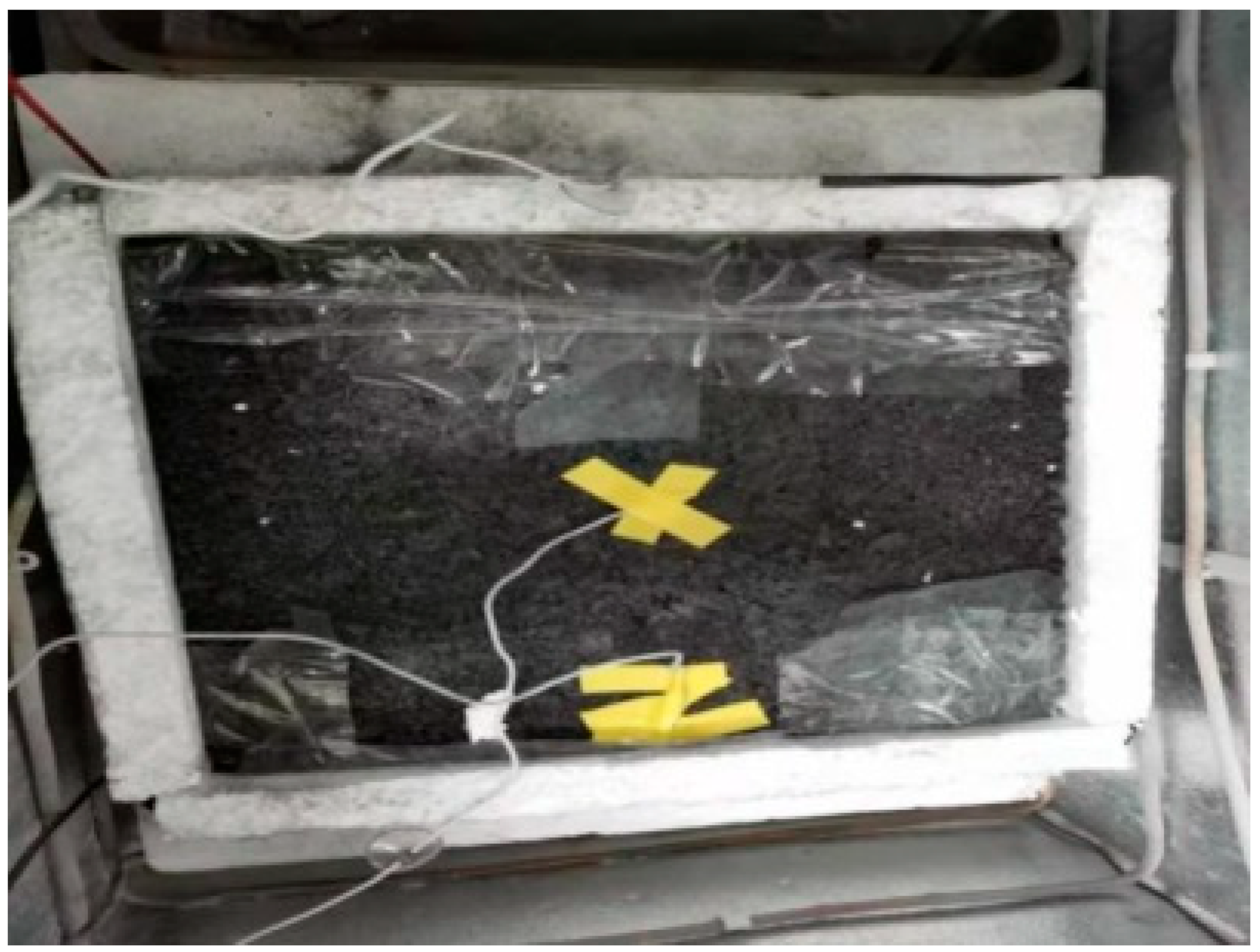
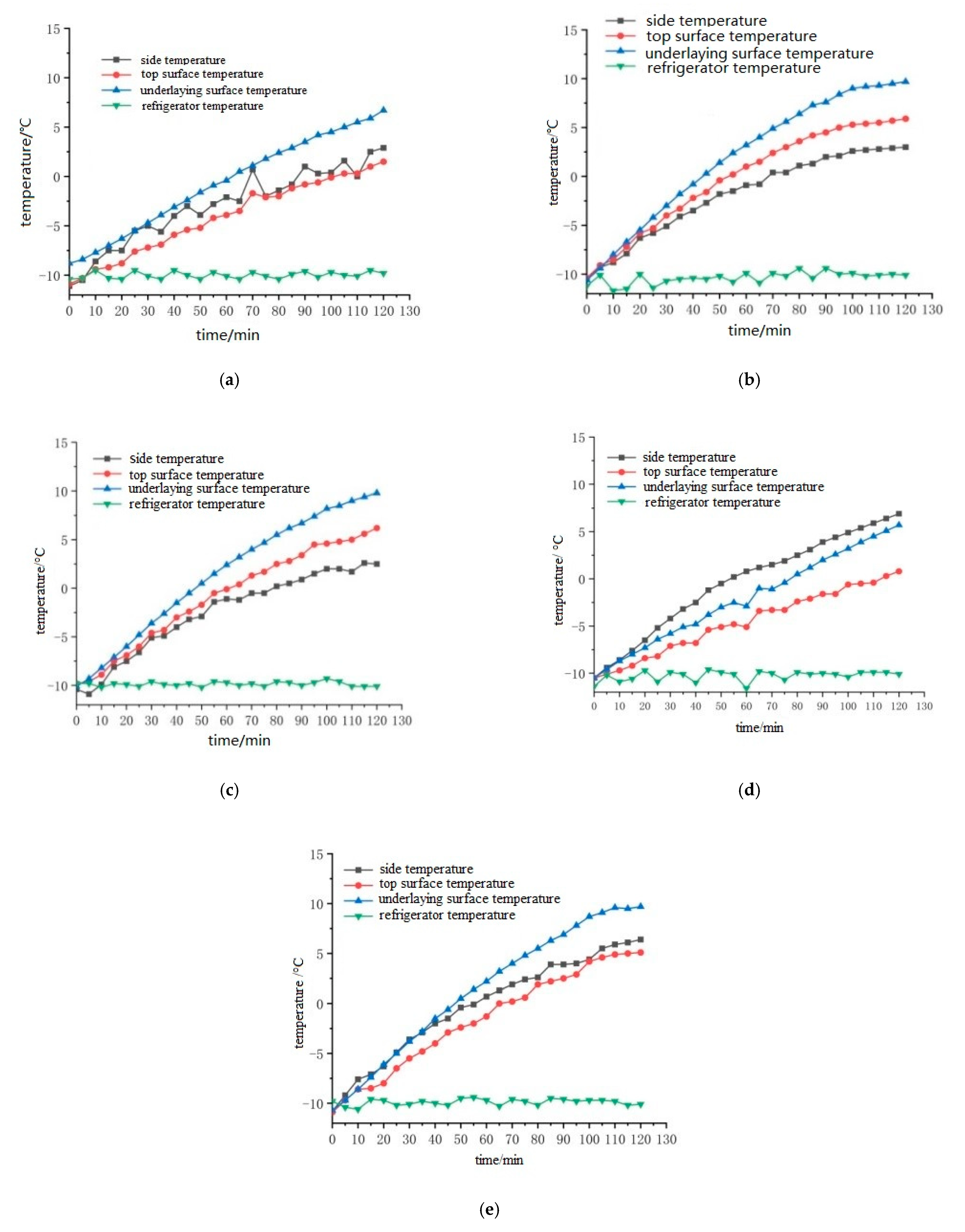
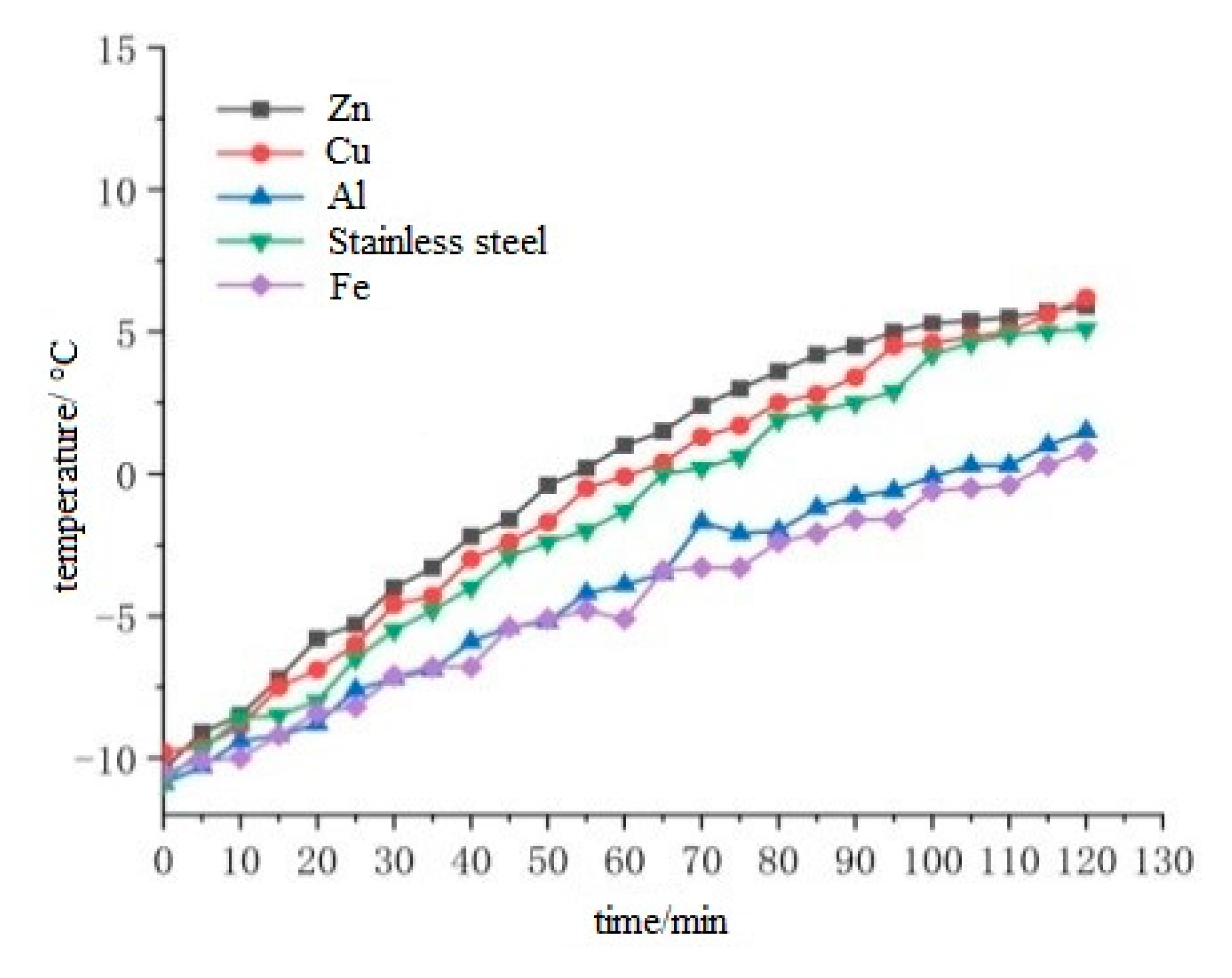
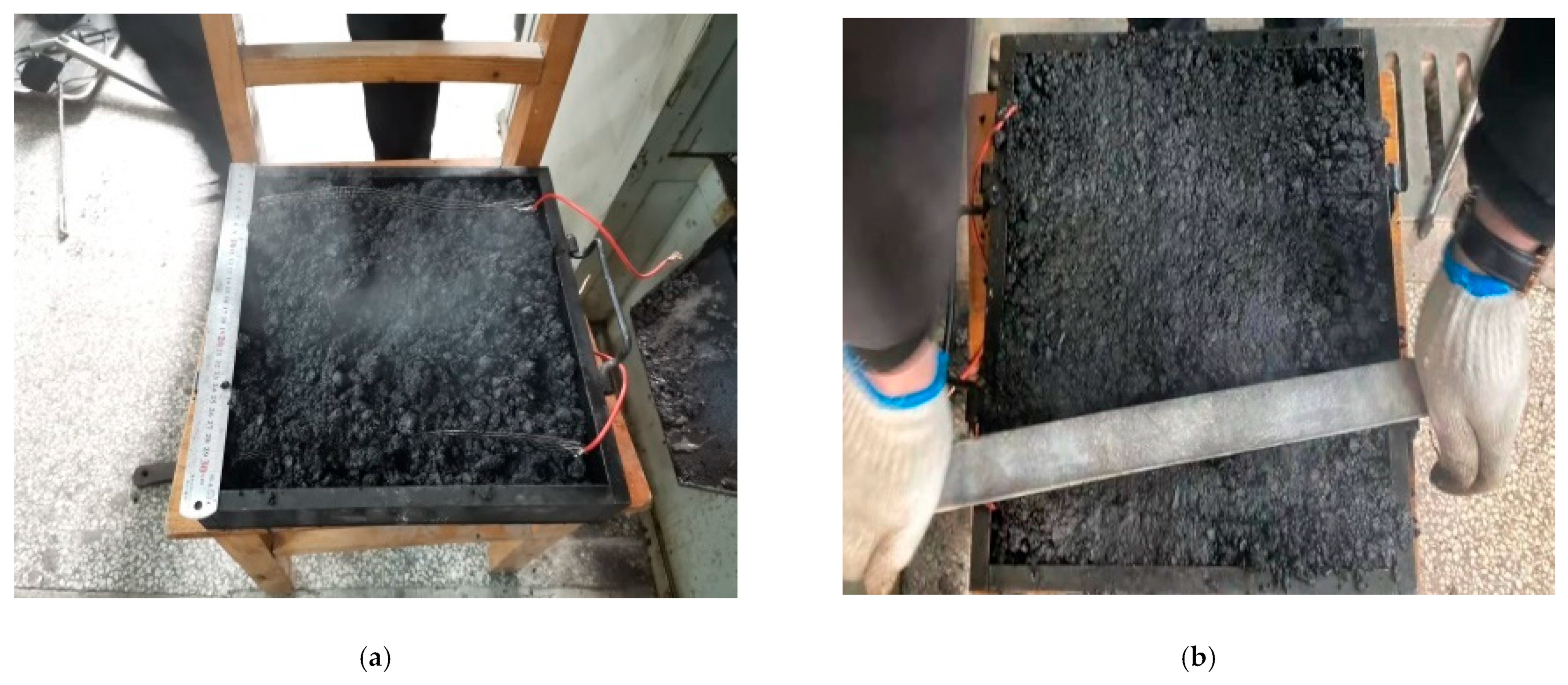
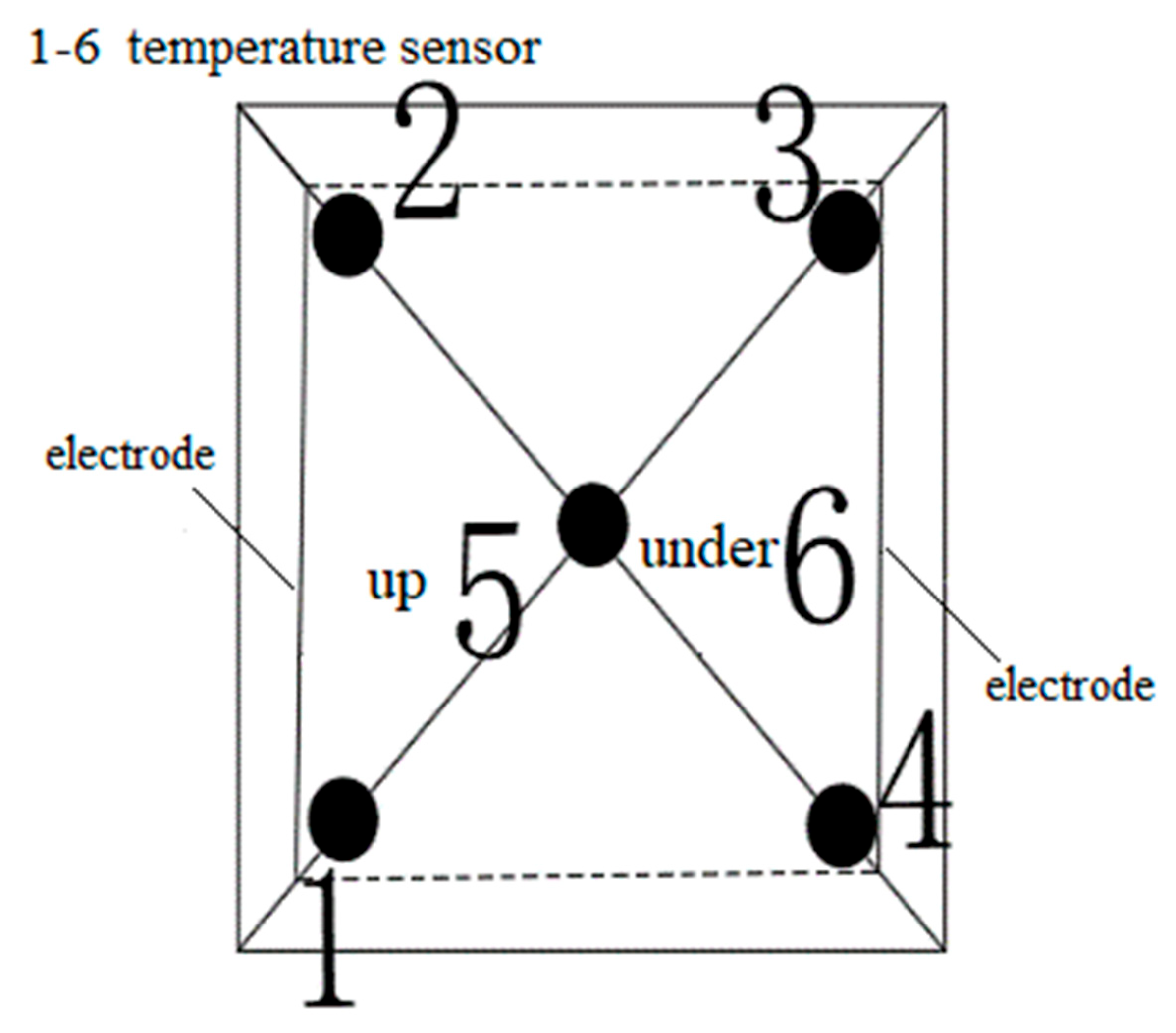
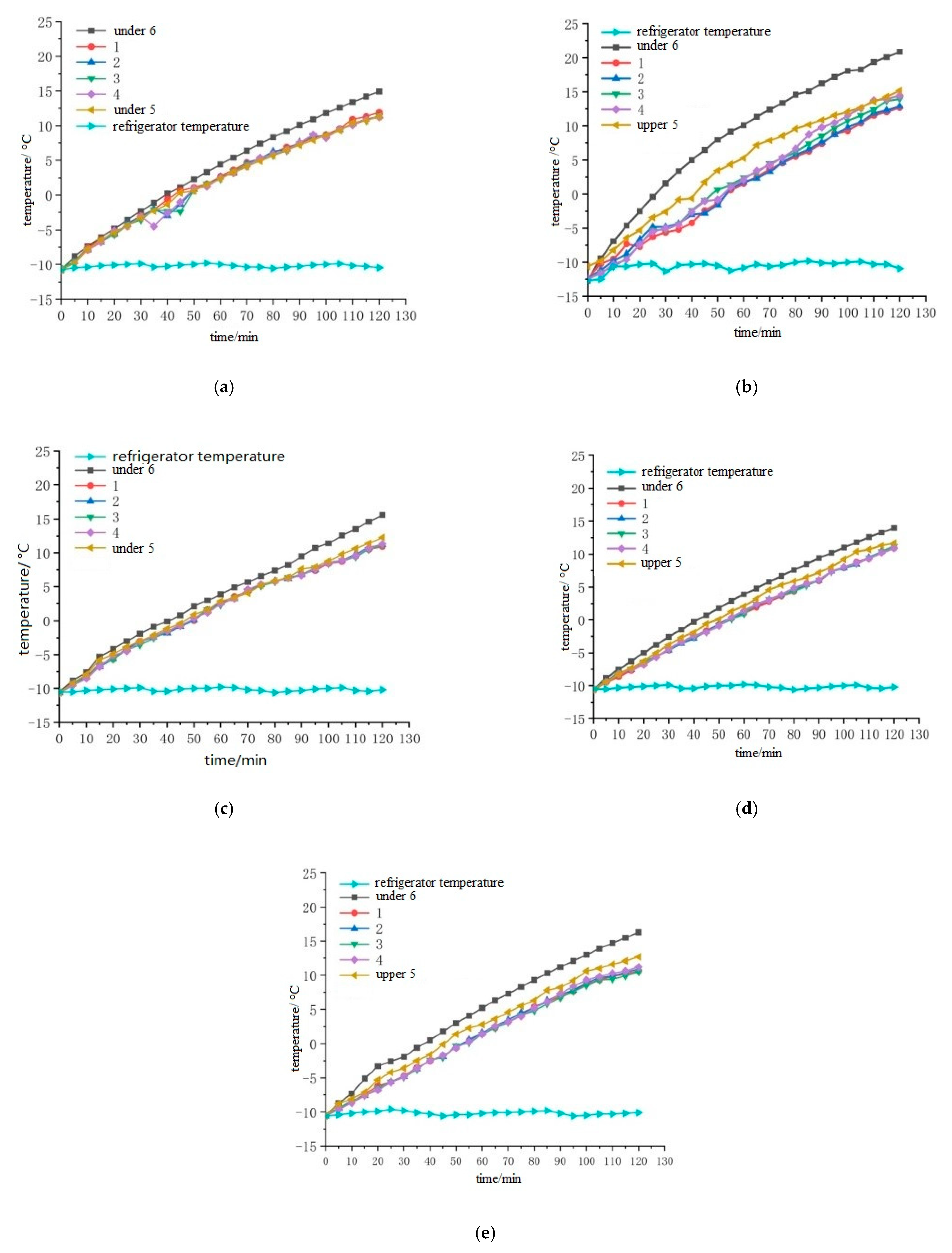


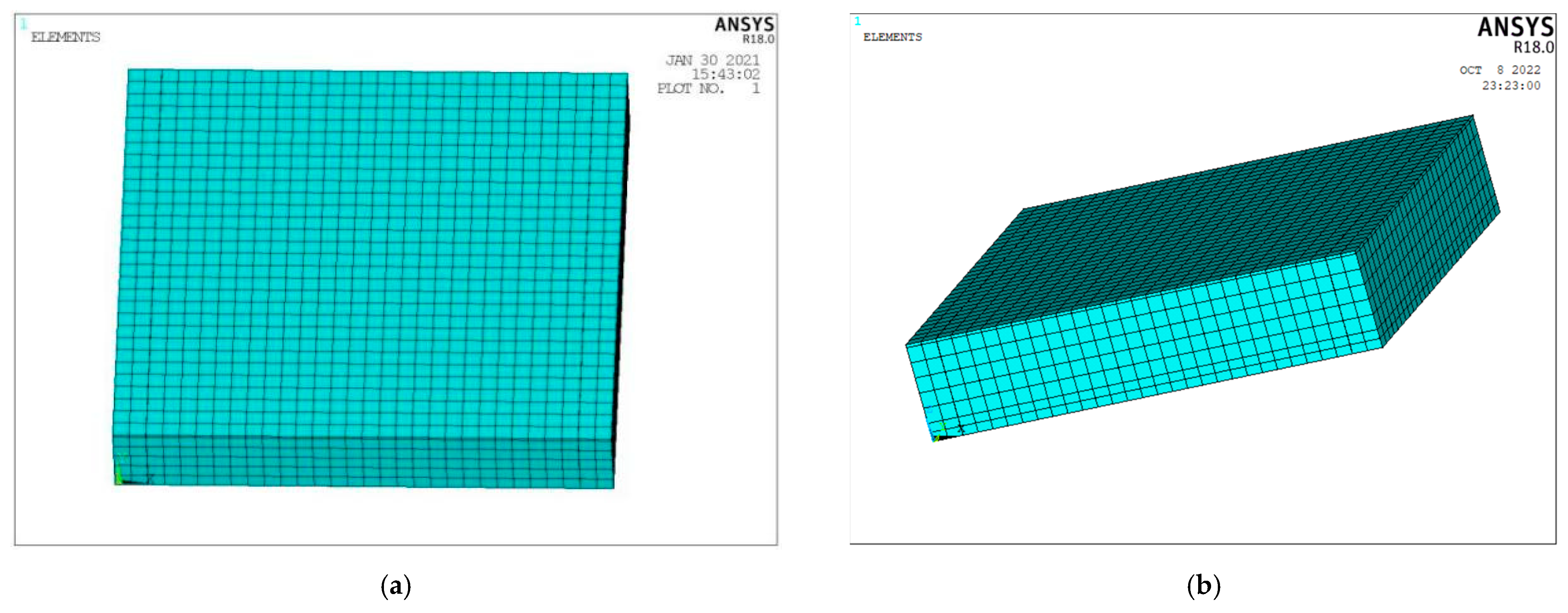
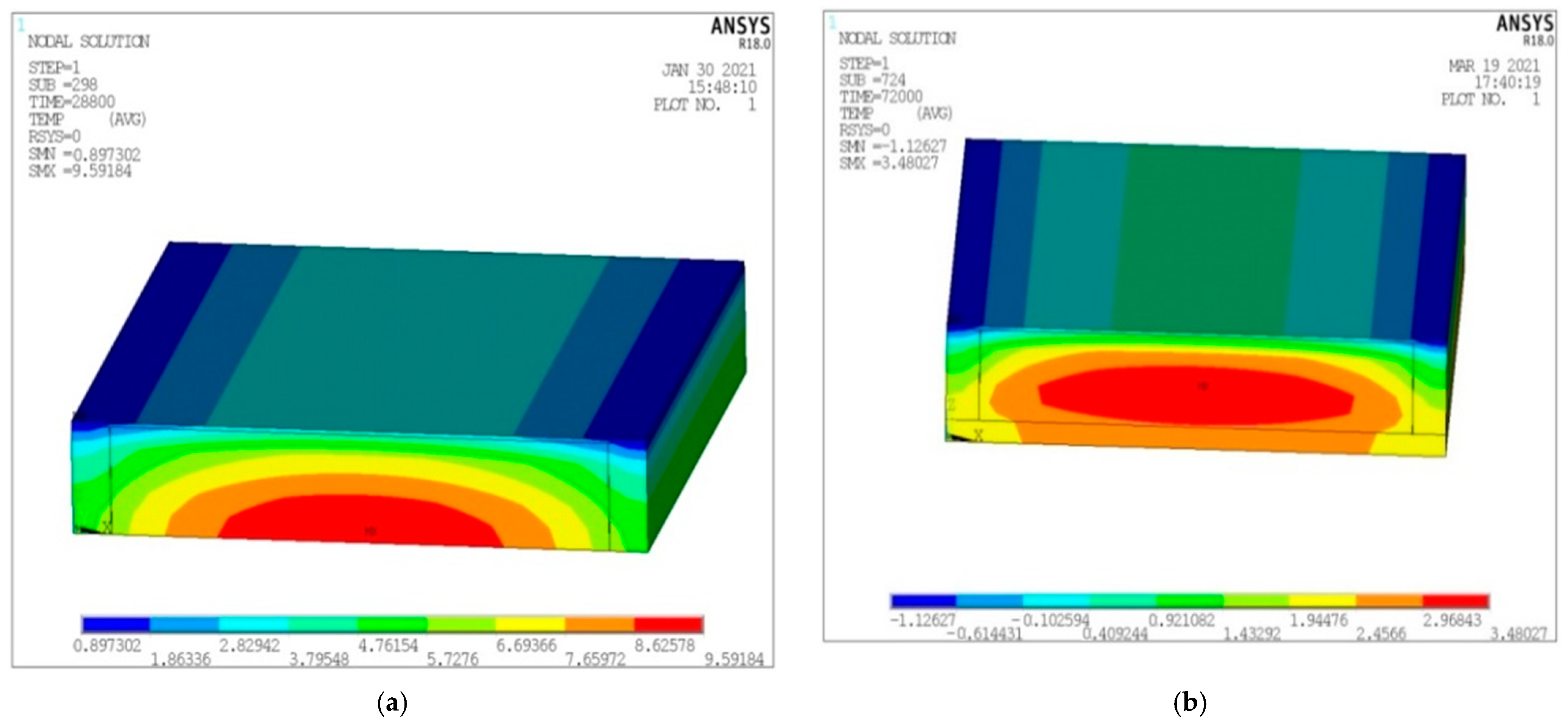

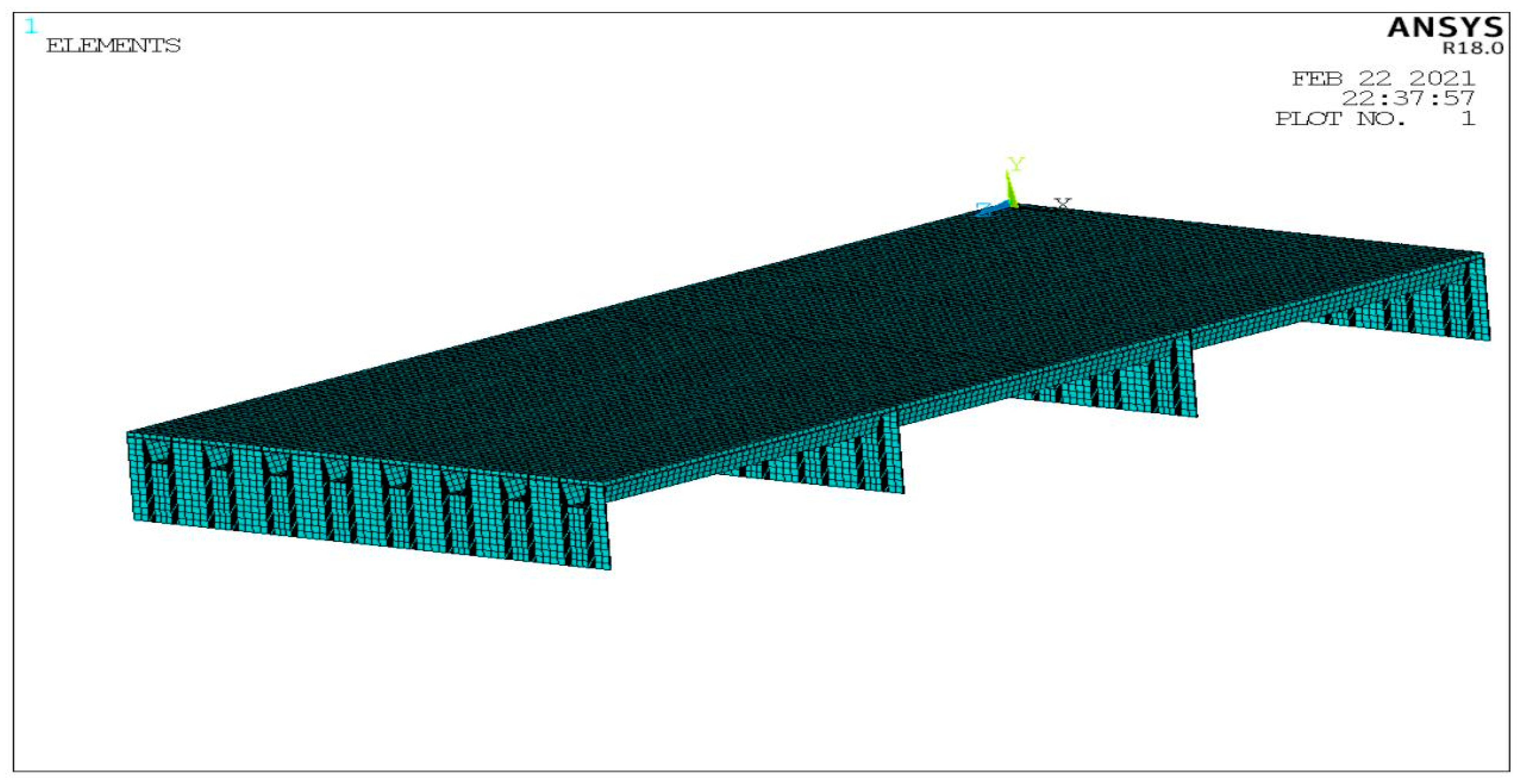
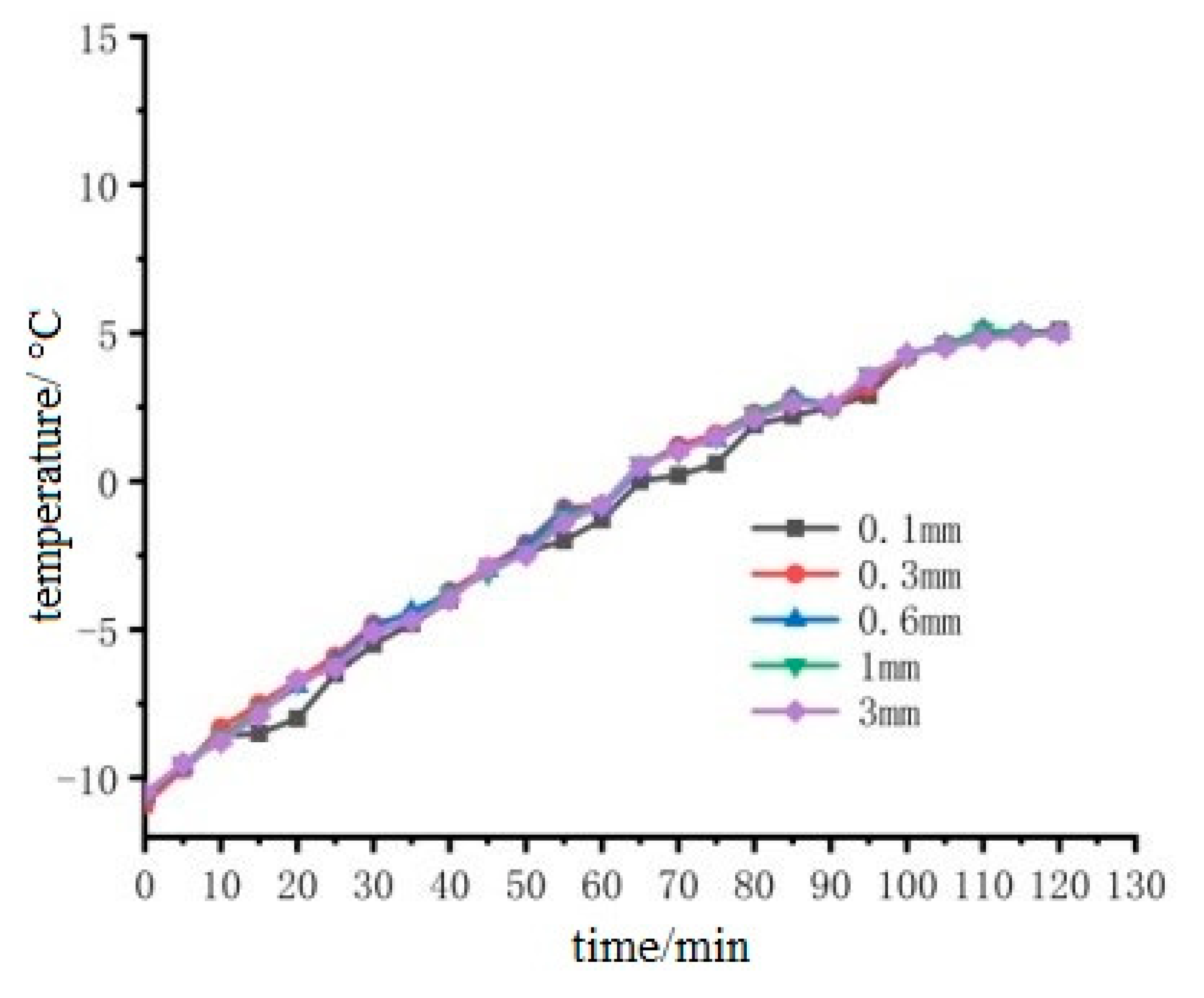


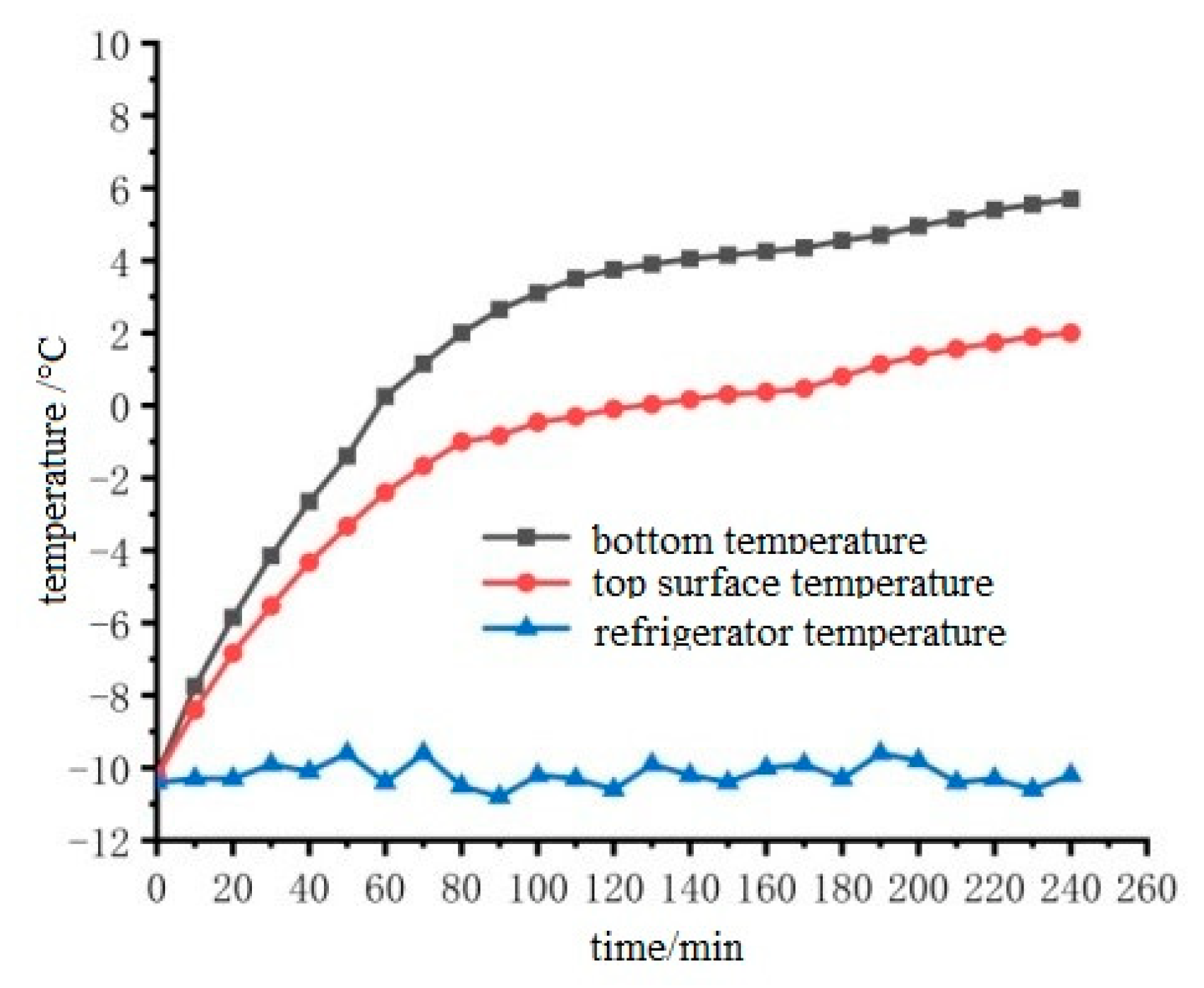
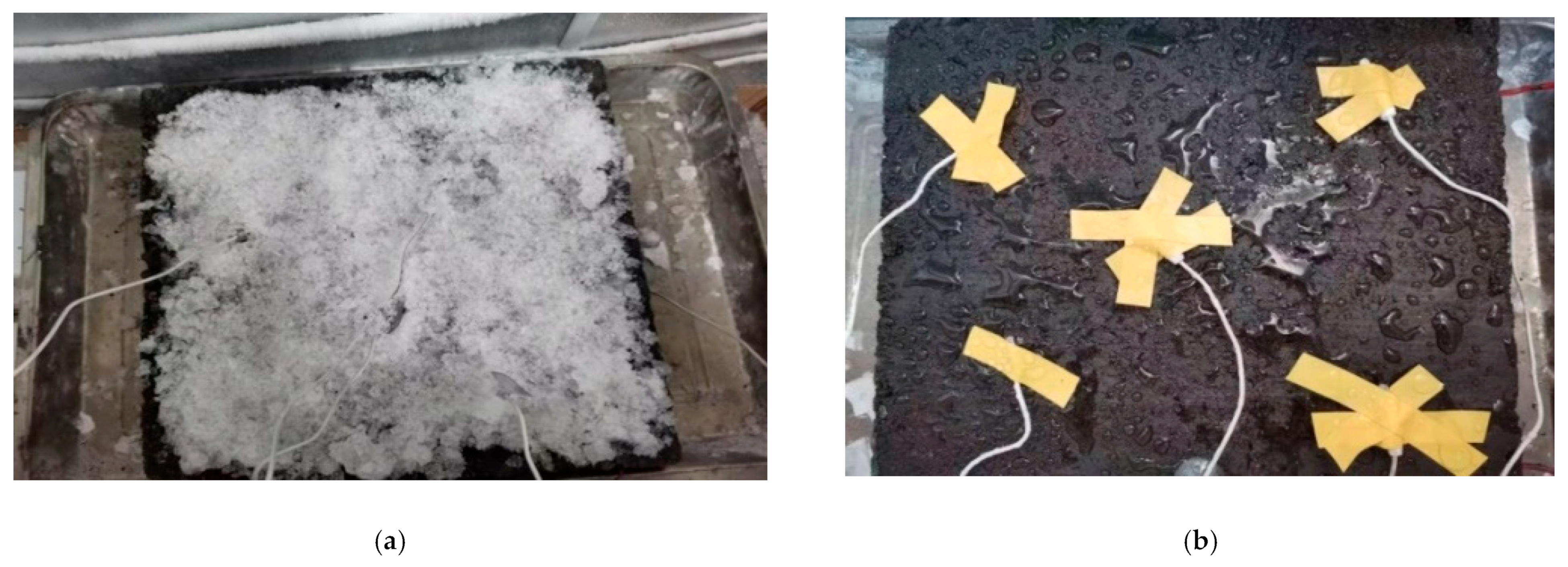
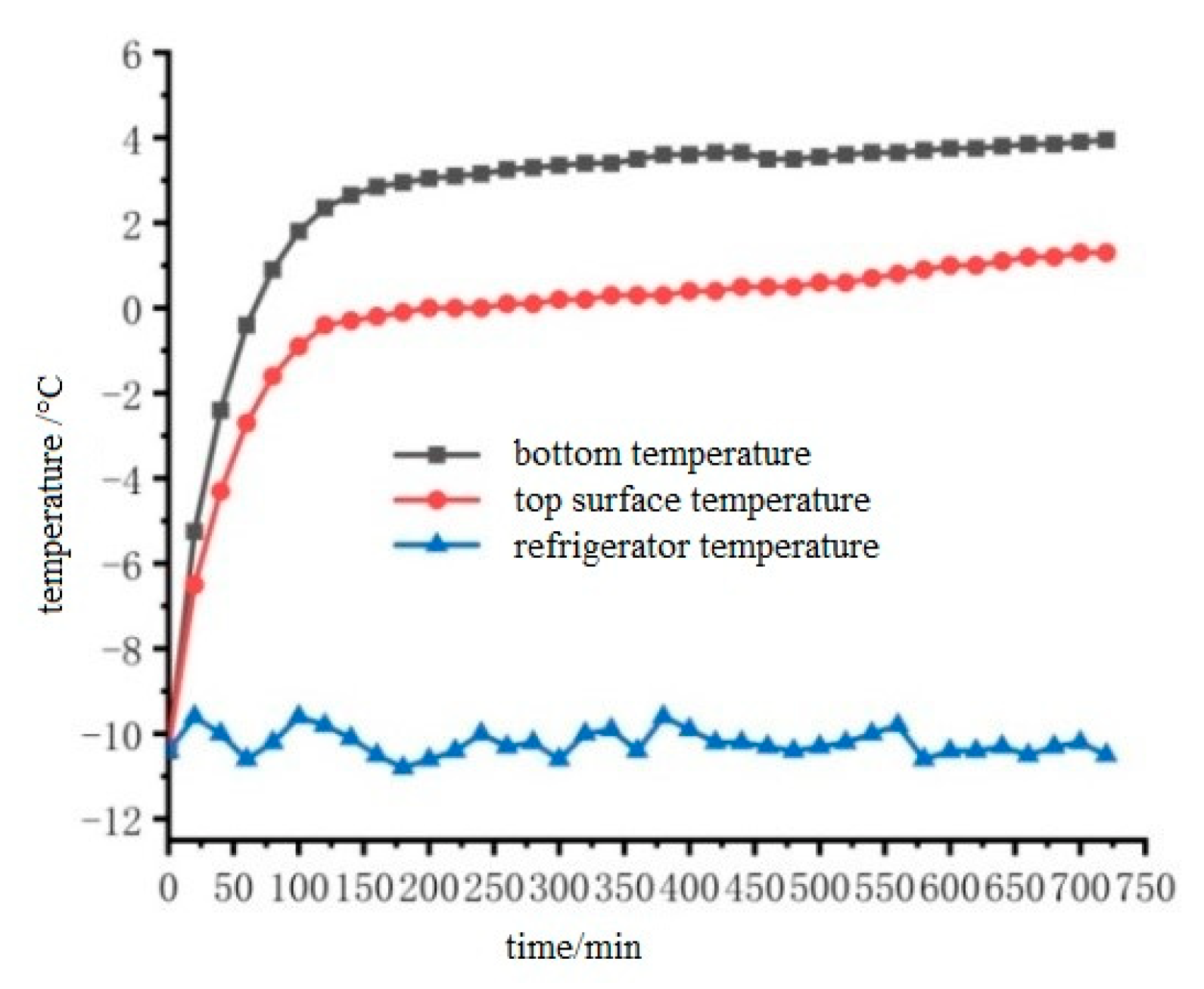
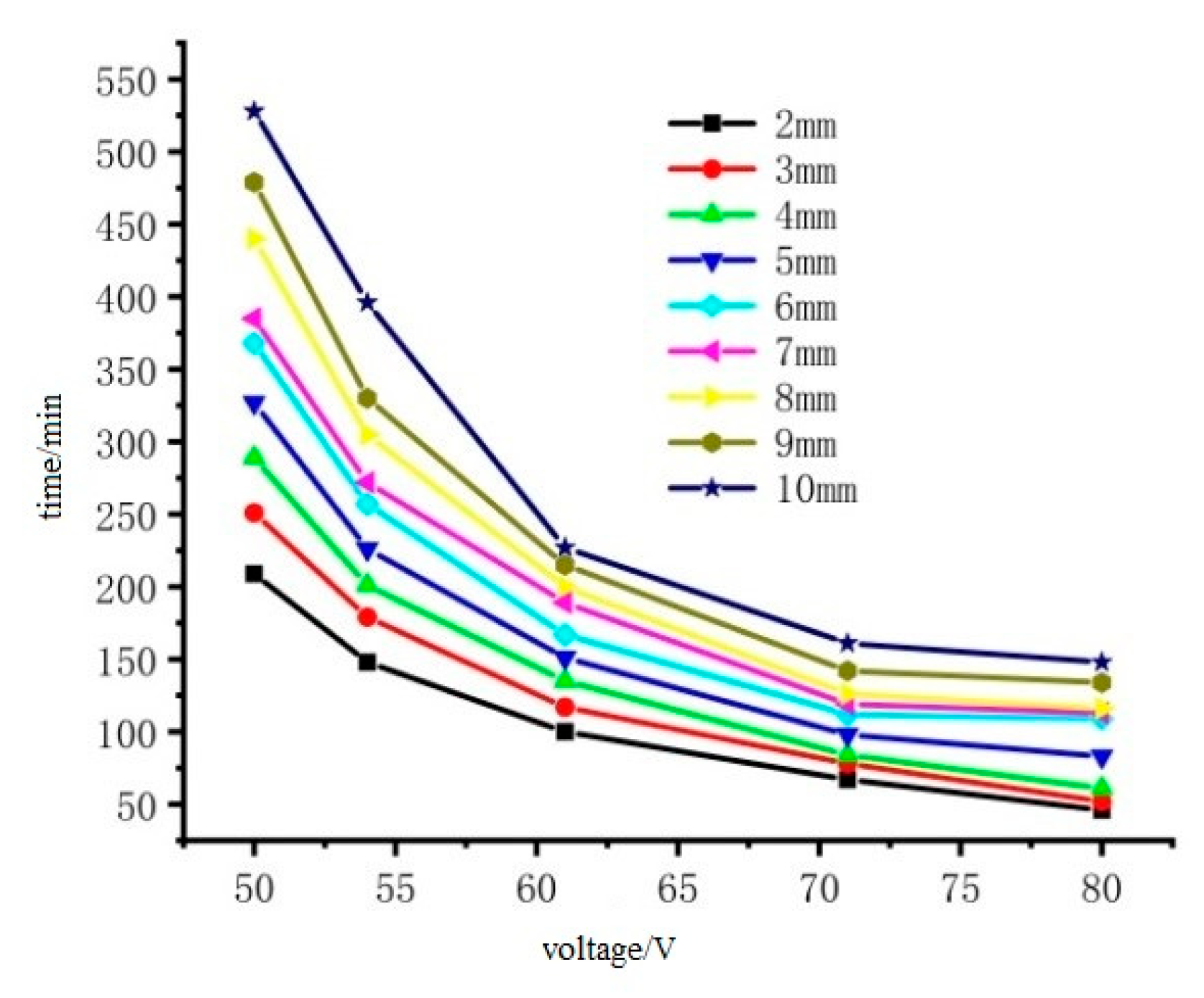
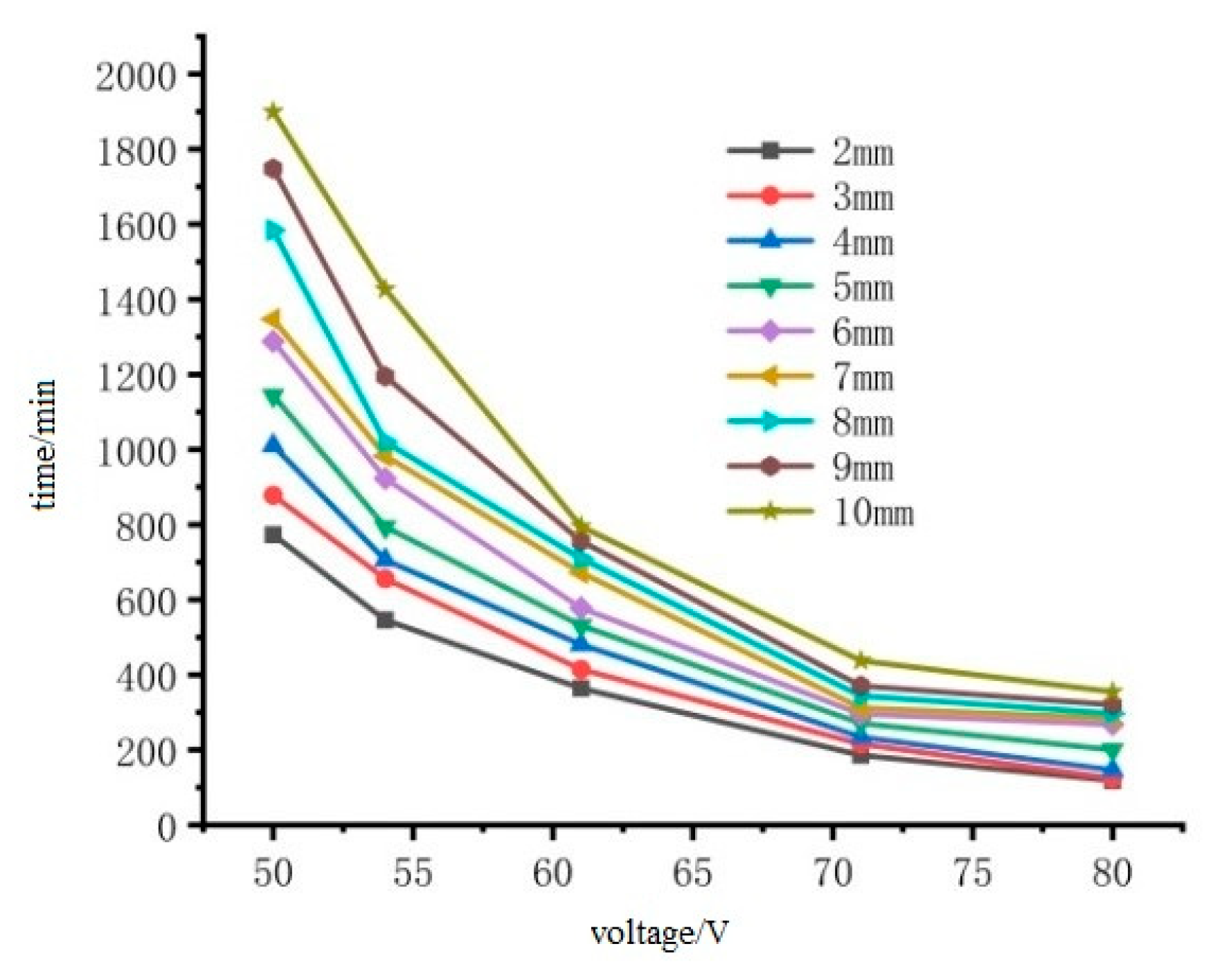

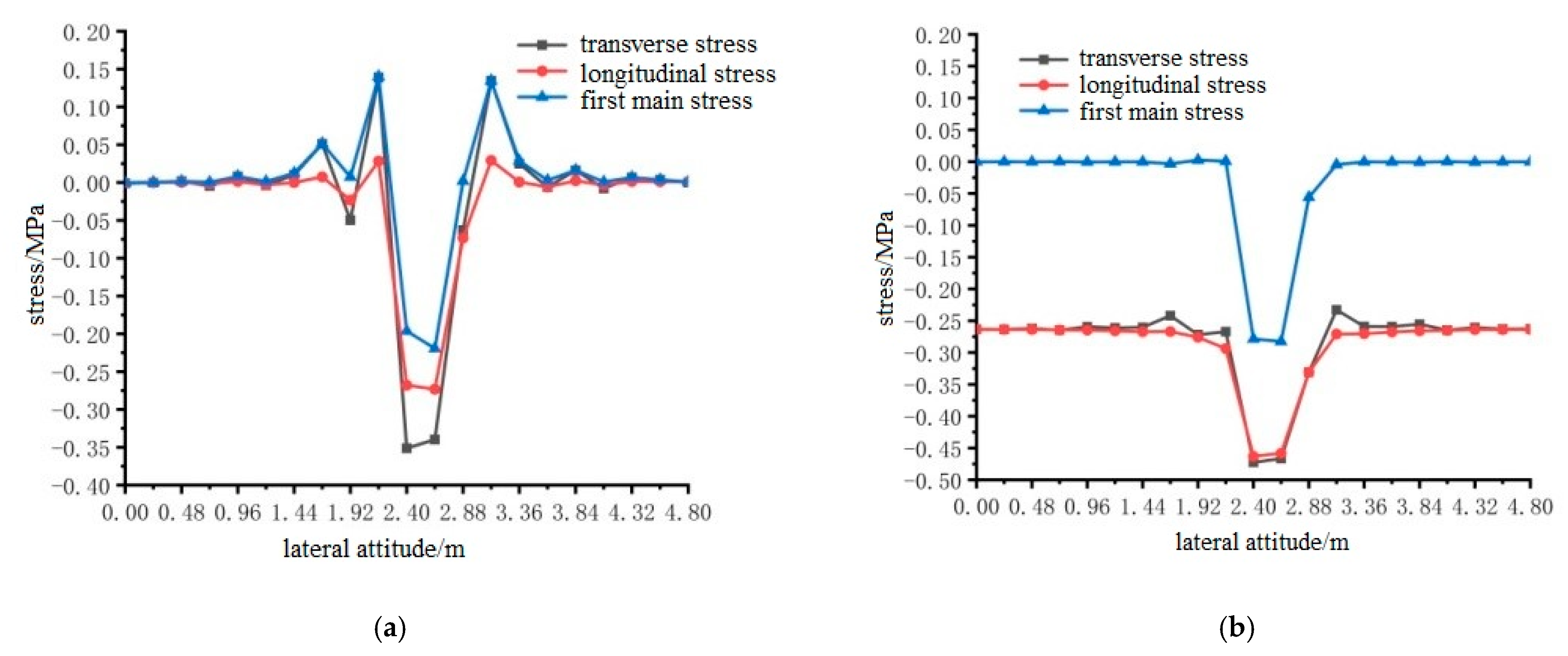

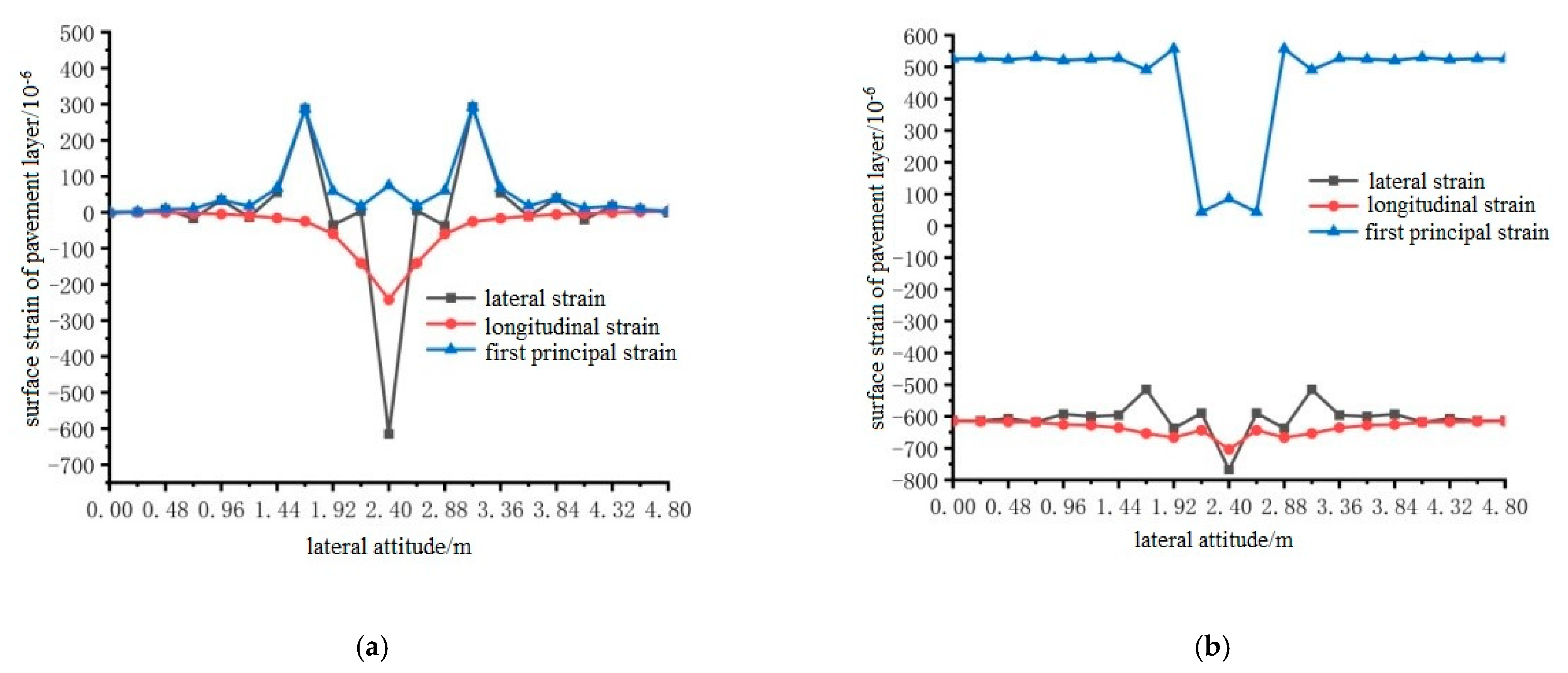
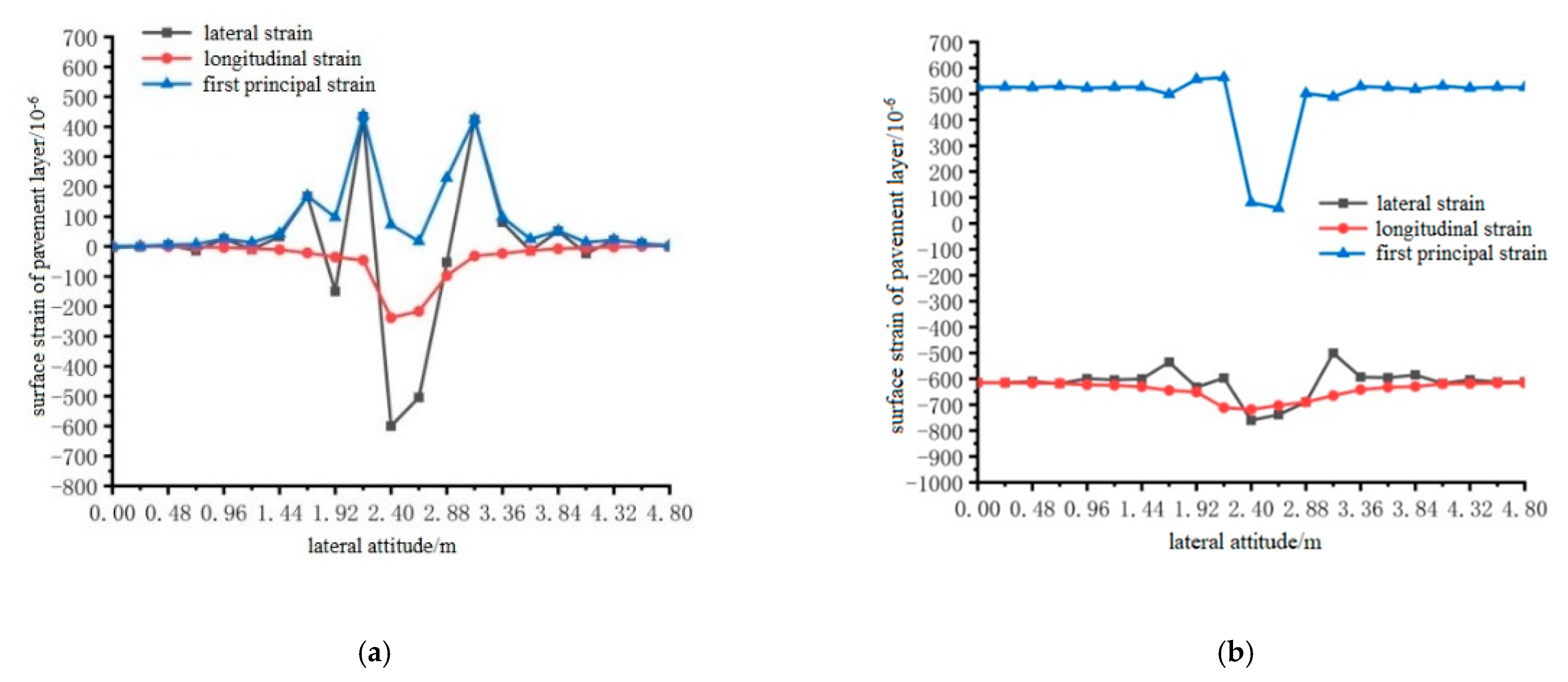
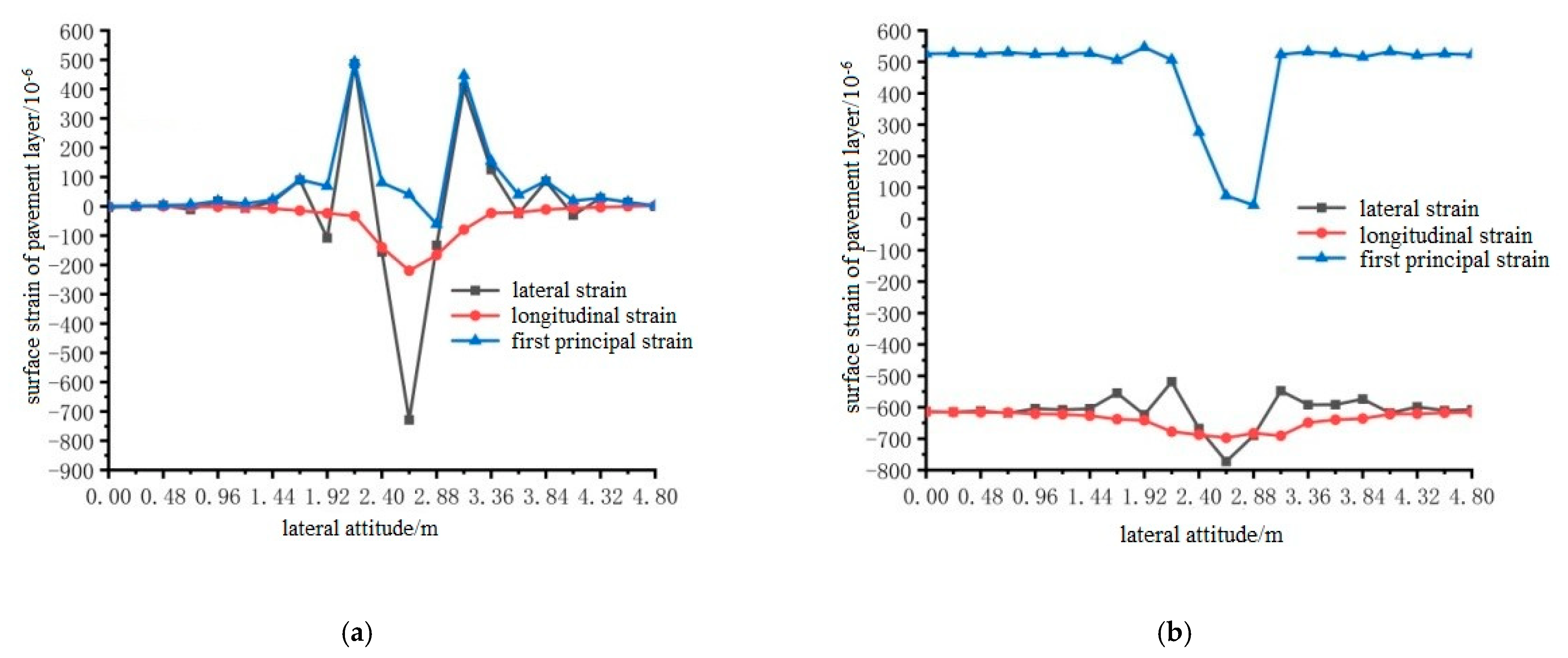

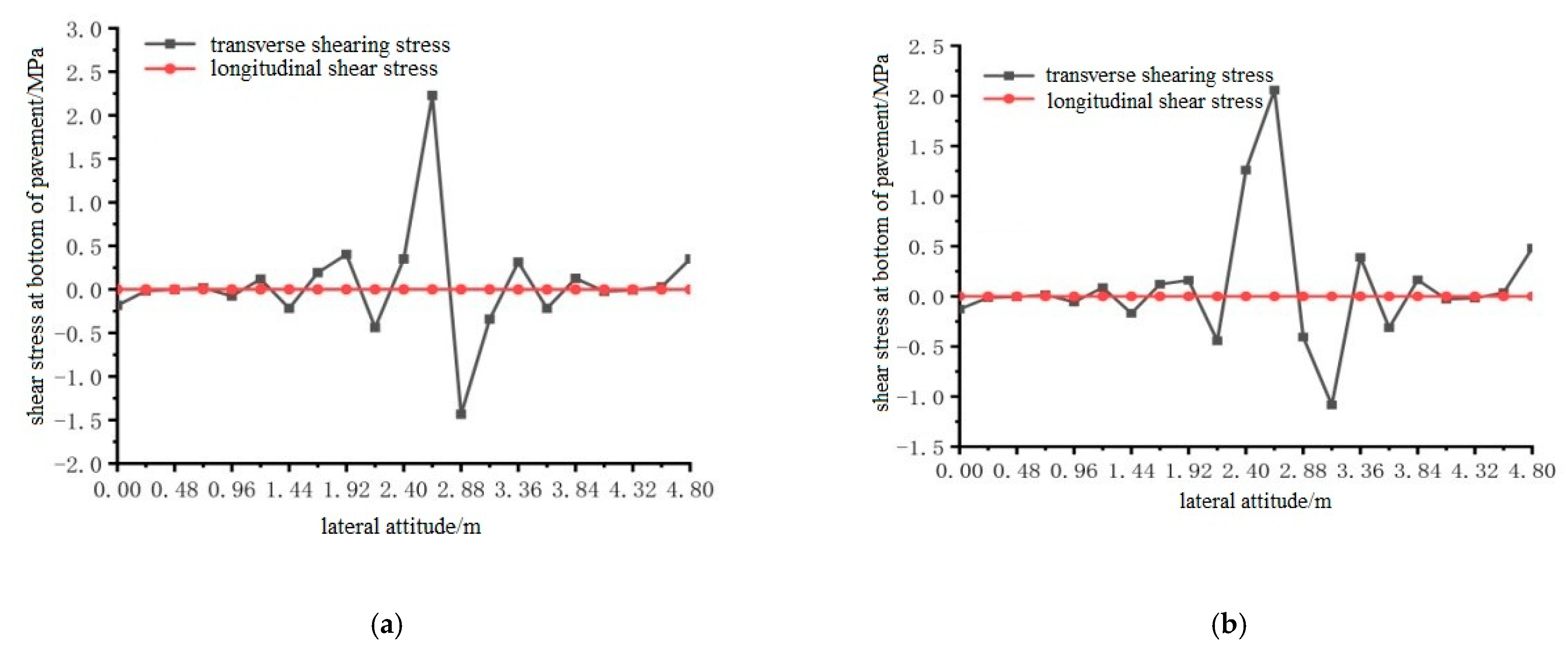

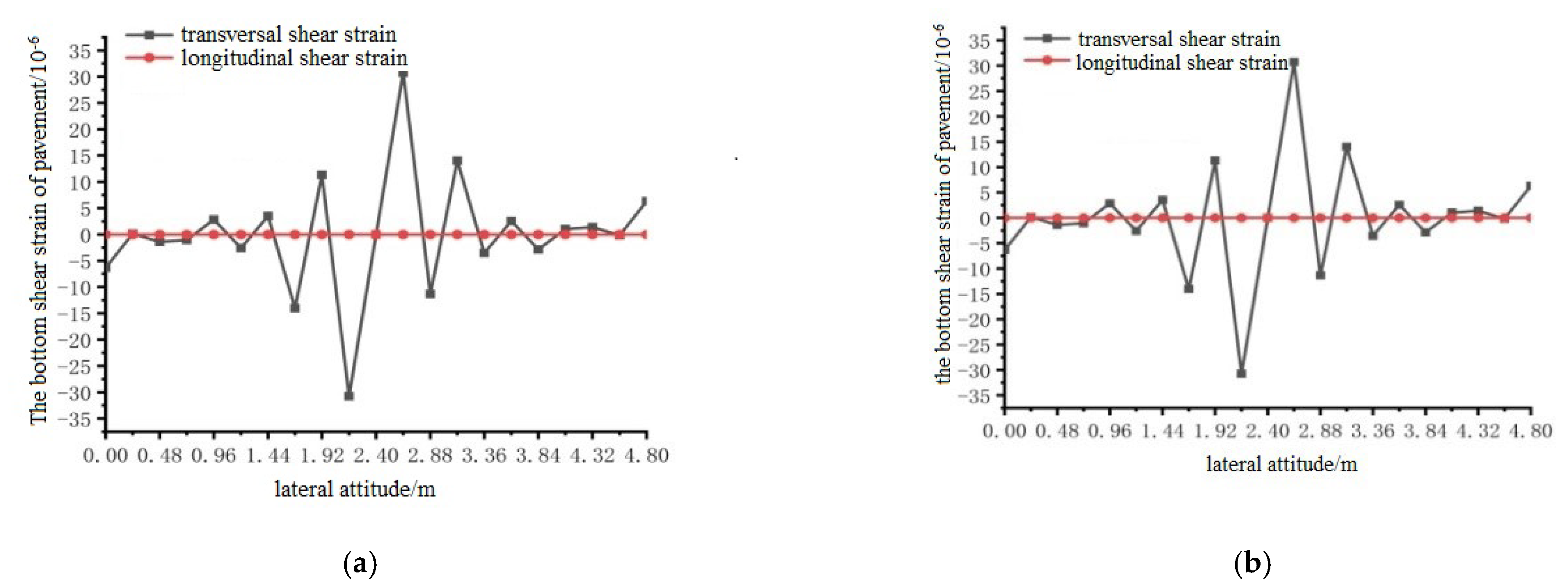
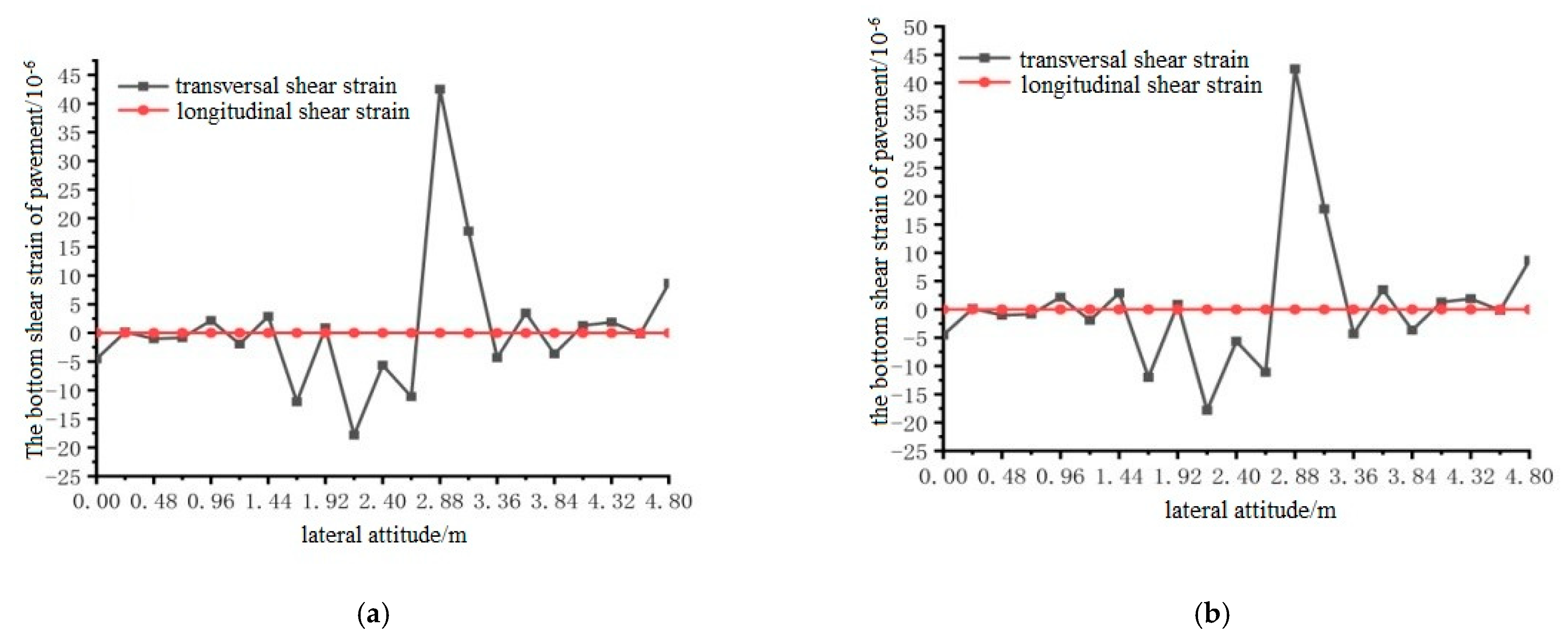

| Index | Test Results | Technical Requirements | |
|---|---|---|---|
| Penetration (25 °C, 100 g, 5 s) | 34 | 10~40 | |
| Softening point/°C | 83.5 | ≮72 | |
| Ductility (5 cm/min, 10 °C)/cm | 32 | ≮10 | |
| Flash point/°C | 266 | ≮240 | |
| Density/(g/cm3) | 1.05 | Actual | |
| After TFOT | Ductility/10 °C | 14 | ≮6 |
| Quality change% | −0.3 | ≯±0.5 | |
| Penetration ratio/% | 78 | ≮65 | |
| Index | Test Results 13.2–9.5 mm 9.5–4.75 mm 4.75–2.36 mm | Technical Requirements | ||
|---|---|---|---|---|
| Crushing value of stone/% | 20.6 | -- | -- | ≯26 |
| Apparent specific density/(g/cm3) | 2.754 | 2.720 | 2.779 | ≮2.60 |
| Hygroscopic rate/% | 1.2 | 1.0 | 1.5 | ≯2.0 |
| Needle and plate particle content/% | 10.7 | 10.4 | -- | ≯15 |
| Particle content by washing method/% | 0.5 | 0.7 | 0.7 | ≯1 |
| Soft stone content/% | 1.9 | 1.9 | 2.4 | ≯3 |
| Index | Test Results 2.36–1.18 mm 1.18–0.6 mm | Technical Requirements | |
|---|---|---|---|
| Apparent specific density/(g/cm3) | 2.791 | 2.787 | ≮2.50 |
| Sand equivalent/% | 76 | 75 | ≮60 |
| Angularity (flow time)/s | 32 | 32 | ≮30 |
| Index | Unit | Determining Value | Technical Requirements | |
|---|---|---|---|---|
| Apparent density | g/cm3 | 2.792 | ≮2.50 | |
| Percent of pass | 0.6 mm | % | 100 | 100 |
| 0.15 mm | 97.6 | 90–100 | ||
| 0.075 mm | 91.7 | 80–100 | ||
| Appearance | -- | no caking | no agglomerates | |
| Hydrophilic coefficient | -- | 0.9 | <1 | |
| Plasticity index | % | 3.6 | <4 | |
| Index | Shape | Density/ (g/cm3) | Particle Size/μm | Carbon Content/% | Ash/% | Iron Content/% | Conductivity/(s/m) |
|---|---|---|---|---|---|---|---|
| Test results | squamose | 2.15 | 150 | 98.7 | 0.2 | 0.3 | 3.2 × 105 |
| Index | Tensile Strength/MPa | Young’s Modulus/GPa | Density/ (g/cm3) | Monofilament Diameter/μm | Carbon Content/% | Filament Length/mm | Conductivity/(s/m) |
|---|---|---|---|---|---|---|---|
| Test results | 4000 | 240 | 1.82 | 10–14 | 98.0 | 6–10 | 2.2 × 103 |
| Electrode | Resistivity/(Ω·m) | Price/(yuan/m) |
|---|---|---|
| Cu | 1.75 × 10−8 | 30 |
| Fe | 9.78 × 10−8 | 12 |
| Zn | 5.9 × 10−8 | 58 |
| Al | 2.83 × 10−8 | 22 |
| Stainless steel | 7.42 × 10−7 | 20 |
| Mesh/mm | 13.2 | 9.5 | 4.75 | 2.36 | 1.18 | 0.6 | 0.3 | 0.15 | 0.075 |
|---|---|---|---|---|---|---|---|---|---|
| Pass rate/% | 100 | 80–100 | 63–80 | 48–63 | 38–52 | 32–46 | 27–40 | 24–36 | 20–30 |
| Median grading | 100 | 90 | 71.5 | 55.5 | 45 | 39 | 33.5 | 30 | 25 |
| Temperature/°C | Enthalpy Value/(J/m3) |
|---|---|
| −40 | 0 |
| −1 | 7.33 × 10−7 |
| 0 | 3.813 × 10−8 |
| 10 | 4.198 × 10−8 |
| Material | Cast Conductive Asphalt Concrete | Stainless Steel | Ice |
|---|---|---|---|
| Thermal conductivity/(W·(m·K)−1) | 2.507 | 80 | 2.2 |
| Specific heat capacity/(J/(kg·K)) | 850 | 460 | 2050 |
| Density/(kg·m−3) | 2500 | 7850 | 917 |
| Resistivity/(Ω·m) | 3.75 | 7.42 × 10−7 | -- |
| Latent heat/ (kJ·kg−1) | -- | -- | 336 |
| Length of Steel Bridge Model/mm | 11,270 | Width of Steel Bridge Deck Model/mm | 4800 |
|---|---|---|---|
| Height of trapezoidal stiffener/mm | 280 | Opening width of trapezoidal stiffener/mm | 300 |
| Trapezoid stiffener spacing/mm | 600 | Closed width of trapezoidal stiffener/mm | 170 |
| Thickness of trapezoidal stiffener/mm | 8 | Steel plate thickness of bridge deck/mm | 14 |
| Diaphragm spacing/mm | 3750 | Height of diaphragm/mm | 1000 |
| Horizontal diaphragm thickness/mm | 10 | Pavement thickness/mm | 50 |
Publisher’s Note: MDPI stays neutral with regard to jurisdictional claims in published maps and institutional affiliations. |
© 2022 by the authors. Licensee MDPI, Basel, Switzerland. This article is an open access article distributed under the terms and conditions of the Creative Commons Attribution (CC BY) license (https://creativecommons.org/licenses/by/4.0/).
Share and Cite
Li, Z.; Guo, T.; Chen, Y.; Yang, W.; Ding, S.; Hao, M.; Zhao, X.; Liu, J. Electrode Layout Optimization and Numerical Simulation of Cast Conductive Asphalt Concrete Steel Bridge Deck Pavement. Materials 2022, 15, 7033. https://doi.org/10.3390/ma15197033
Li Z, Guo T, Chen Y, Yang W, Ding S, Hao M, Zhao X, Liu J. Electrode Layout Optimization and Numerical Simulation of Cast Conductive Asphalt Concrete Steel Bridge Deck Pavement. Materials. 2022; 15(19):7033. https://doi.org/10.3390/ma15197033
Chicago/Turabian StyleLi, Zhenxia, Tengteng Guo, Yuanzhao Chen, Wenping Yang, Shengquan Ding, Menghui Hao, Xu Zhao, and Jinyuan Liu. 2022. "Electrode Layout Optimization and Numerical Simulation of Cast Conductive Asphalt Concrete Steel Bridge Deck Pavement" Materials 15, no. 19: 7033. https://doi.org/10.3390/ma15197033





